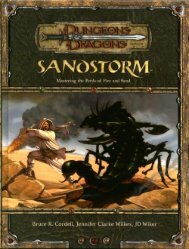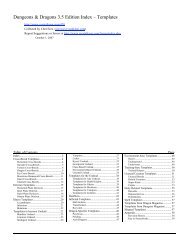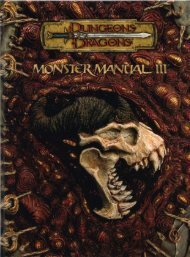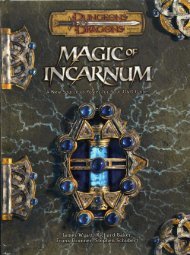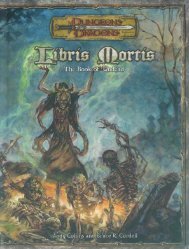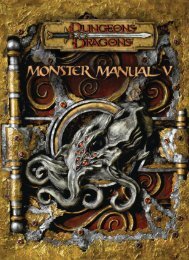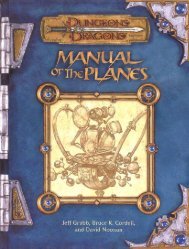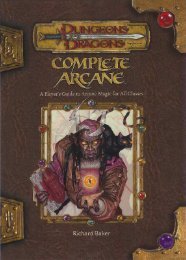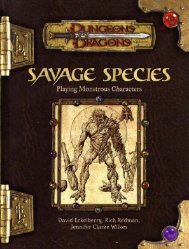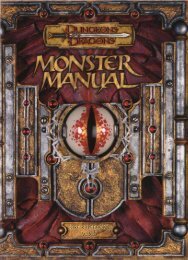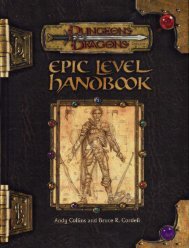CHAPTER 2HALFLINGS60Donta muden sito Donta likin menli—grunti la danko. “Findinga gullible person is like finding a purse in the road—takeit quickly and move on.” Fortune can come in many forms, somake the best <strong>of</strong> your opportunities. Still, don’t hang aroundin one place waiting for more. If you wait on the road foranother purse to drop, you’ll eventually be run over. Likewise,if you stick around after conning someone, you’ll certainlybe caught.Kendit hilto pintith ento nitli. “A lie is a spear with a pointat each end.” It can be useful to tell a lie once in a while, butlike a two-headed spear, it can skewer you if you push it intoo hard.Rundo enka rindo, endi likni supa, la mento illli nitka sento. “Awheel’s rim is round, but its spokes are straight, and neitheris any good without the other.” This saying is a reminder thatdisparate elements can work together to form a useful whole.Paditma sinti bimini nibit, endi paditnim sinti latamin. “Abird in the hand means a morsel on the table, but a bird inthe bush means song in the morning.” These words remindthe listener that some efforts might produce inferior resultsin the long run. Sometimes it is best to let things developbefore acting.Sobenit rill modot allin vento fimit soga. Wenlit modit gimlitvemit fimil nodoti. “Pity the farmer who curses the rain becauseit might spoil the hay. Yesterday he cursed the droughtbecause it was spoiling the roots.” This saying is a warningagainst seeing the cloud around every silver lining. It is alsoa jibe toward sedentary folk.HALFLING LETTERINGThe Halfling alphabet consists <strong>of</strong> twenty-two characters anduses the Common script. Since so little is written down inHalfling, few studies have been done on how its renderingdiffers from Common.NAMINGUnlike dwarves or elves, who bear their names with pride,halflings do not attach great importance to names. Althougha halfling does not change her clan name (unless it becomesadvisable to do so in order to avoid difficulties), she may useand discard several names over the course <strong>of</strong> her life as hercircumstances and perspective change.Each halfling name consists <strong>of</strong> one or more name fragments(from Table 2–2) and possibly an earned name (from Table2–3). When combining two halfling name fragments, an “o”or “ee” is frequently added between them. Female halflingTable 2–1: Halfling Name Generatord20 Result1–3 Roll once on Table 2–2.4–9 Roll twice on Table 2–2.10–13 Roll once on Table 2–2 for a first name and twicefor a last name.14–18 Roll twice on Table 2–2 for a first name and twicefor a last name.19–20 Roll twice on Table 2–2 for a first name and twiceon Table 2–3 for an earned name.Table 2–2: Sample Halfling Namesd% Name Meaning01–03 Arv Badger, fearless, fierce04–05 Baris Curse, fool, hapless, unlucky06–08 Brand Adventurous, bold, courage, hero09–10 Bren Black, cold, dark, night11–13 Cal Curious, joker, quest, riddle14–15 Chen Beard, hairy, handsome, warm16–18 Cyrr Defender, elder, strong19–20 Dair Playful, rascal, thief21–23 Dal Home, provider, shield24–25 Deree Brother/sister, squire, stout26–28 Dric Donkey, lazy, pony, stubborn29–30 Eere Deer, high, jumping, tall31–33 Essel Arrow, bow, fleet, flying34–35 Fur Comfortable, common, heritage, snug36–38 Galan Burrow, earth, field, house39–40 Gen Bargain, diligent, merchant, trader41–43 Gren Baker, cook, feast, green, plenty44–45 Ien Blue, clean, sweet, water46–48 Illi Big, deity, greatest, power49–50 Indy Beautiful, forest, kind, woodland51–53 Iss Festive, gala, happy, village54–56 Kal Cunning, fox, prankster57–58 Kep Child, small, young59–61 Kin Dance, dancing, fire, quick62–63 Li Bard, legendary, story64–66 Llalee Food, happy, hearth, home67–68 Lur Hard, stone, white69–71 Mel Lad/maiden, playful, wild72–73 Opee Cheese, lasting, timeless, yellow74–76 Ped Cherry, copper, red77–79 Pery Flower, love, loyal, romance80–82 Penel Crafter, merit, valuable, weaver83–85 Reen Peaceful, peacekeeper, sheriff, warrior86–88 Rill Farm, farmer, food, life89–90 Royl Divine, eternal, immortal91–92 Sheel Air, clouds, rainy, weather93–95 Thea Feet, honor, proud96–97 Ur Deadly, final, judge, stern98–99 Wort Brown, herb, silent, mushroom100 Yon Father/mother, teacher, wiseTable 2–3: Halfling Earned Namesd% Named% Name01–02 Bones51–53 Moon03–05 Caller54–56 Nimble06–08 Cloak57–58 Quick09–10 Earth59–60 Reed11–12 Eye61–63 Shadow13–15 Fast64–66 Silver16–18 Foot67–68 Skin19–20 Glen69–71 Sly21–22 Glitter72–74 Small/Little23–24 Gold75–76 Smooth25–26 Hand77–79 Stout27–29 Heart80–82 Strider30–32 Hill/hillock 83–85 Sun33–34 Hollow86–87 Swift35–37 Honor88–89 Thistle38–40 Laughing90–91 Wanderer41–43 Leaf92–93 Warm44–45 Lightning 94–96 <strong>Wild</strong>46–47 Man/Lady 97–98 Will48–50 Meadow99–100 Whisper
names sometimes double the last consonant and add an“-a” (thus, Furgren becomes Furgrenna). If you don’t like aparticular combination, try adding an “a,” “i,” or “y” betweenthe name fragments, or add “-en” or “-enna” to the end. Notevery combination <strong>of</strong> name fragments will sound right; if youcan’t make a particular name work, try to create one with asimilar meaning.The definitions for halfling names sometimes end up beingno more than a list <strong>of</strong> pleasant things. Calopee might mean“cheese and riddles” and still be a well-respected halflingname. Of course, it might also mean “the timeless quest”—orit might mean both. Halflings enjoy playing with their names’definitions and might decide to change a definition just toconfuse a friend or member <strong>of</strong> another race.Earned names are descriptors or titles given to individualsafter some important or heroic event. Although these nameswere once given in the halflings’ native tongue, they arenow usually in the Common tongue due to the influence <strong>of</strong>human culture. A halfling character might acquire an earnedname during game play or start the game with an earnedname. An earned name can be randomly determined byrolling twice on Table 2–3, or you can choose one to matcha character’s personality.HALFLING CARAVANSAND TOWNSMost halflings spend their lives wandering from place toplace, with lengthy stops wherever they find pleasure andpr<strong>of</strong>it. Most <strong>of</strong> this traveling is done by wagon in caravans,but some is by boat.A campsite is chosen based on the length <strong>of</strong> the proposedstay. A site for a one-night stay should be defensible, have asizable clear space for wagons, and provide some water andgrazing for the animals. It should also be free <strong>of</strong> obviouspredators and preferably out <strong>of</strong> sight <strong>of</strong> hostile forces suchas orc bands. In addition to the above, a site for a longer stayrequires a good water source, abundant hunting, wood forfires and for wagons, and plenty <strong>of</strong> wild roots and berriesfor gathering. Halflings rarely worry about replanting whatthey have taken; they simply move on when resources runlow and trust to nature to replenish the land over time.Selection <strong>of</strong> a site for a permanent settlement is something<strong>of</strong> a serendipitous process because it depends largely on thecharity <strong>of</strong> those who own the land. Defense, water, wood,food, and grazing lands are all desirable, but halflings learnto make do with the lands to which they receive rights. Thebest lands have not only the basic resources but also rawmaterials for various crafts.A permanent halfling settlement is described below asboth a reference for DMs looking to design their own andas a location for use in a campaign that features halflings.HALFLING ECONOMYWithin a halfling community, most commerce is done on abarter system; halflings do not like to carry large amounts <strong>of</strong>money in their wagons, feeling this makes them attractivetargets to bandits. Since most halfling caravans operatelike extended families anyway (and some are, when theclans are closely related), this system comes naturally toits members.However, halflings do regularly trade with outsiders, andthey do accumulate money. On rare occasions, halflingswithin the same caravan may pay one another in money forgoods or services, but such transactions are frowned upon.Money is usually reserved for commerce with outsiders.Halflings sell their goods and services and accumulatecash reserves to tap when needed. They deposit most <strong>of</strong>their cash with a “banker,” a settled halfling either in alarge human city or in a permanent halfling town. Thoughsome bankers use or invest money in a depositor’s absence,most leave it buried, hidden, or safely cached on theirproperty, knowing that the depositor can ask for all <strong>of</strong> itat a moment’s notice.Halfling communities do not mint any coins <strong>of</strong> their own,though they do sometimes melt down recognizable treasureand form it into jewelry or gold bars. Halflings know the value<strong>of</strong> all other cultures’ currency, and bankers can change onecurrency to another for a small fee.EXAMPLE SETTLEMENT:FANTA’S MEADOWFanta’s Meadow is situated on a forty-acre piece <strong>of</strong> meadowlandadjoining several farms in a rural area populatedby humans. A stream cuts through the southern half <strong>of</strong> themeadow, providing water for the crops the halflings chooseto grow and for their orchards. The soil is rich, and aboutone-fourth <strong>of</strong> the land is naturally wooded. A rocky ridgestretches along the northern side <strong>of</strong> the property.The town was named for the halfling clan leader whonegotiated its use. The land was deeded to the halflings inperpetuity by a grateful human wizard for whom the halflingsdid a great favor.The business section <strong>of</strong> Fanta’s Meadow consists <strong>of</strong> twolong, rambling, two-story buildings that stretch for a quartermileand more on either side <strong>of</strong> a wide main street. Thesestructures house a number <strong>of</strong> shops, all <strong>of</strong> which connectwith one another. A customer can literally walk throughtwo dozen shops without leaving the shelter <strong>of</strong> the building.Crafting areas, such as forges and ovens, <strong>of</strong>ten extendoutdoors, behind the row <strong>of</strong> shops. The proprietor <strong>of</strong> eachshop can fence goods related to his or her craft.Toward the south end <strong>of</strong> town is an immense open areawhere caravans can park. At either end <strong>of</strong> this area are tavernsthat have a few rooms for rent.The ridge on the north side <strong>of</strong> town contains numerous burrowshollowed out from the stone and secured with woodendoors. A few <strong>of</strong> the townspeople live in these undergroundhomes, but most live in rooms above their shops. Most <strong>of</strong>these burrows belong to traveling halflings who come hereto stay during seasons <strong>of</strong> inclement weather. The typicalburrow consists <strong>of</strong> a kitchen, a living room, a family room,CHAPTER 2HALFLINGS61
- Page 2:
C R E D I T SD E S I G NSKIP WILLIA
- Page 7 and 8:
no elf could predict which memory w
- Page 9 and 10: premium. Thus, each individual can
- Page 11 and 12: The elves have raised one form of e
- Page 13 and 14: do spend time away from one another
- Page 15 and 16: espects during this time, and those
- Page 17 and 18: Stores Master: Charged with keeping
- Page 19 and 20: would be the birthright of any full
- Page 21 and 22: of feet above the forest floor. Mos
- Page 23 and 24: Cleric Training: More than any othe
- Page 25 and 26: ELF HISTORYAND FOLKLOREThe elves cl
- Page 27 and 28: along with her son Hionyron, who wa
- Page 29 and 30: and return her to her people.” In
- Page 31 and 32: Table 1-3: Suffixesd% Suffix Meanin
- Page 34: CHAPTER 1ELVES34tri-level tree home
- Page 37 and 38: Illus. by C. Lukacsurious and activ
- Page 39 and 40: the reason for the farmer’s hospi
- Page 41 and 42: Halflings make a visitor feel welco
- Page 43 and 44: Halflings are usually pleasant trav
- Page 45 and 46: Halflings are as eager to experienc
- Page 47: A chief or elder heads each clan, c
- Page 50 and 51: CHAPTER 2HALFLINGS50away from their
- Page 52 and 53: CHAPTER 2HALFLINGS52Illus. by S. Wo
- Page 54 and 55: CHAPTER 2HALFLINGS54to tell how lon
- Page 56 and 57: CHAPTER 2HALFLINGS56the underbrush
- Page 58 and 59: CHAPTER 2HALFLINGSIllus. by T. Baxa
- Page 63 and 64: and one or more bedrooms. All have
- Page 65 and 66: Illus. by C. Lukacshe cliff-dwellin
- Page 67 and 68: Personality: Raptorans have a reput
- Page 69 and 70: PSYCHOLOGYSome outsiders who have h
- Page 71 and 72: for making a point through a logica
- Page 73 and 74: flock for debate, sometimes invitin
- Page 75 and 76: its eggs. At such times, they toler
- Page 77 and 78: THE RAPTORAN PANTHEONThe typical ra
- Page 79 and 80: Prayers: Prayers to the Stormfather
- Page 81 and 82: “Welcome, friend,” said a human
- Page 83 and 84: year since, and they share the care
- Page 85 and 86: D: Domain spell. Domains: Protectio
- Page 87 and 88: characteristics are summarized in t
- Page 90 and 91: CHAPTER 3RAPTORANS90Authority Figur
- Page 92 and 93: CHAPTER 4OTHERRACES92a humanlike ra
- Page 94 and 95: CHAPTER 4OTHERRACES94ment, finding
- Page 96 and 97: CHAPTER 4OTHERRACES96Illus. by S. B
- Page 98 and 99: Table 4-1: The CentaurHit Base Atta
- Page 100 and 101: CHAPTER 4OTHERRACES100nomadic gnoll
- Page 102 and 103: Table 4-2: The GnollBase Fort Ref W
- Page 104 and 105: CHAPTER 4OTHERRACES104of the humano
- Page 106 and 107: CHAPTER 4OTHERRACESsneak attack, bu
- Page 108 and 109: CHAPTER 5PRESTIGECLASSES108Shadowda
- Page 110 and 111:
CHAPTER 5PRESTIGECLASSESIllus. by W
- Page 112 and 113:
CHAPTER 5PRESTIGECLASSES112the foll
- Page 114 and 115:
CHAPTER 5PRESTIGECLASSES114Entry Re
- Page 116 and 117:
CHAPTER 5PRESTIGECLASSESIllus. by J
- Page 118 and 119:
CHAPTER 5PRESTIGECLASSESLUCKSTEALER
- Page 120 and 121:
CHAPTER 5PRESTIGECLASSESIllus. by J
- Page 122 and 123:
CHAPTER 5PRESTIGECLASSESEL 11: Kuly
- Page 124 and 125:
CHAPTER 5PRESTIGECLASSES124spellcas
- Page 126 and 127:
CHAPTER 5PRESTIGECLASSES126save bon
- Page 128 and 129:
CHAPTER 5PRESTIGECLASSESmore than o
- Page 130 and 131:
CHAPTER 5PRESTIGECLASSES130raptoran
- Page 132 and 133:
CHAPTER 5PRESTIGECLASSES132Table 5-
- Page 134 and 135:
CHAPTER 5PRESTIGECLASSESfriendly—
- Page 136 and 137:
CHAPTER 5PRESTIGECLASSESYou no long
- Page 138 and 139:
CHAPTER 5PRESTIGECLASSES138small fe
- Page 140 and 141:
CHAPTER 5PRESTIGECLASSES140ranger.
- Page 142 and 143:
CHAPTER 5PRESTIGECLASSESIllus. by T
- Page 144 and 145:
CHAPTER 5PRESTIGECLASSESEncountersP
- Page 146 and 147:
CHAPTER 6CHARACTEROPTIONS146Conditi
- Page 148 and 149:
CHAPTER 6CHARACTEROPTIONS148If the
- Page 150 and 151:
CHAPTER 6CHARACTEROPTIONSIllus. by
- Page 152 and 153:
CHAPTER 6CHARACTEROPTIONSIllus. by
- Page 154 and 155:
CHAPTER 6CHARACTEROPTIONSIllus. by
- Page 156 and 157:
Table 6-3: Elf Ranger Racial Substi
- Page 158 and 159:
Table 6-5: Halfling Druid Racial Su
- Page 160 and 161:
CHAPTER 6CHARACTEROPTIONS160Table 6
- Page 162 and 163:
Class SkillsRaptoran fighter substi
- Page 164 and 165:
CHAPTER 7EQUIPMENTAND MAGICIllus. b
- Page 166 and 167:
CHAPTER 7EQUIPMENTAND MAGIC166anoth
- Page 168 and 169:
CHAPTER 7EQUIPMENTAND MAGICTable 7-
- Page 170 and 171:
CHAPTER 7EQUIPMENTAND MAGICIllus. b
- Page 172 and 173:
CHAPTER 7EQUIPMENTAND MAGICIllus. b
- Page 174 and 175:
2nd-Level Ranger SpellWoodland Veil
- Page 176 and 177:
WOODLAND VEILIllusion (Glamer)Level
- Page 178 and 179:
CHAPTER 8CAMPAIGNS INTHE WILD178THE
- Page 180 and 181:
CHAPTER 8CAMPAIGNS INTHE WILDIllus.
- Page 182 and 183:
CHAPTER 8CAMPAIGNS INTHE WILD182(lo
- Page 184 and 185:
CHAPTER 8CAMPAIGNS INTHE WILD184Ski
- Page 186 and 187:
CHAPTER 8CAMPAIGNS INTHE WILD186Tab
- Page 188 and 189:
CHAPTER 8CAMPAIGNS INTHE WILDIllus.
- Page 190 and 191:
CHAPTER 8CAMPAIGNS INTHE WILDIllus.
- Page 192:
APPENDIX19261 Guards are needed to
- Page 195 and 196:
2THE CLIFFThe Rifinti dwelling lies
- Page 198 and 199:
supplies for craftwork. Lamps fuele
- Page 200 and 201:
Nae’fidrim: Female owl companion;
- Page 202 and 203:
Creatures: A cleric is always on du
- Page 204 and 205:
cloak of elvenkind, oil of magic we
- Page 206:
aptoran contraries. If visitors can



